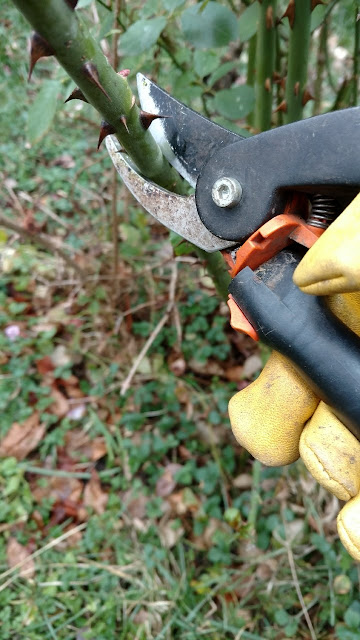
Tips for winter rose care start with sharp shears

|
|
Sharp pruning shears and thick gloves are
crucial to successful (and safe) rose pruning.
(Photo: Debbie Arrington)
|
It’s pruning time! Now is when rose lovers get busy. Our bushes need some TLC if we want healthy growth and abundant flowers next spring – and for months to follow.
The best time to prune in Sacramento usually is between Dec. 15 and Valentine’s Day. Colder weather coaxes roses into dormancy during that period. Their spent blooms will develop into rose hips, the rose’s fruit. They’ll finally drop their leaves – and any remains of fungal infections.
Pruning fosters a healthier environment for roses. It revitalizes the bush and resets its biological clock. It improves air flow (which combats fungal disease) and eliminates dead wood (which could be harboring pests). It allows the rose to be the best it can be.
Before you prune, take time to get your tools in order. Use “bypass” pruners or loppers; as you prune, one blade passes by the other to create a cleaner cut and not bruise the stem or branch. (The alternative is anvil pruners, which pinch the stems.)
Sharpen your pruners and long-handled loppers before you start cutting. Sharp tools make clean cuts that heal quickly.
Here's an excellent video on sharpening hand pruners, filmed by the UCCE Master Gardeners of Sacramento County: https://youtu.be/k9AddV33lpw
Wear thick gloves -- preferably leather. Protect your hands and arms. Rose prickles may contain dangerous bacteria that can cause serious illness, even death. Don't get pricked.
Another must-have tool: Disinfectant. This can be Lysol spray (or similar) or wipes. Between each bush, spray or wipe your pruner and lopper blades. That quick dose of disinfectant can save lots of future grief; while pruning, it eliminates the inadvertent spread of disease from one rose to another.
Prune taller. Instead of taking a bush to the ground (or nearly so), prune hybrid tea bushes to about waist high – 3 feet tall. You’ll have blooms sooner next spring because the bush doesn’t have to take weeks to regrow to its basic size.
But do prune. If not pruned, the bush’s new growth will be on top of its old growth and tangled into a prickly mess. The bush can reach easily reach 8 to 10 feet tall – and probably become too big for its space.
When pruning, remove ALL the remaining foliage on each bush. Those old leaves often carry fungal spores that will infect spring growth shortly after it appears.
After pruning, rake up all the fallen leaves and other debris under the bush and remove it. Don’t compost it; it likely contains lots of fungal spores that you don’t want to recycle into your garden.
Once they’re pruned, surround your roses with fresh mulch, 1 to 2 inches deep. Aged compost works well. So do small wood chips or dried tree leaves. Avoid mounding mulch over the graft where the bush’s budwood is attached to its rootstock. Otherwise, the rootstock is likely to sprout. That mulch also protects the bush’s tender roots from any frost danger.
Put off fertilizing until late February. Right now, you want your roses to rest up for the bloom-filled year ahead.
Comments
0 comments have been posted.Sacramento Digs Gardening to your inbox.
Sites We Like
Garden Checklist for week of May 5
Survey your garden after the May 4 rainstorm. Heavy rain and gusty winds can break the neck of large flowers such as roses. Also:
* Keep an eye on new transplants or seedlings; they could take a pounding from the rain.
* Watch out for powdery mildew. Warmth following moist conditions can cause this fungal disease to “bloom,” too. If you see a leaf that looks like it’s dusted with powdered sugar, snip it off.
* After the storm, start setting out tomato transplants, but wait on the peppers and eggplants (they want warmer nights). Pinch off any flowers on new transplants to make them concentrate on establishing roots instead of setting premature fruit.
* Trim dead flowers but not leaves from spring-flowering bulbs such as daffodils and tulips. Those leaves gather energy to create next year's flowers. Also, give the bulbs a fertilizer boost after bloom.
* Pinch chrysanthemums back to 12 inches for fall flowers. Cut old stems to the ground.
* Mulch around plants to conserve moisture and control weeds.
* From seed, plant beans, beets, cantaloupes, carrots, corn, cucumbers, melons, pumpkins, radishes and squash.
* Plant onion sets.
* In the flower garden, plant seeds for asters, cosmos, celosia, marigolds, salvia, sunflowers and zinnias. Transplant petunias, zinnias, geraniums and other summer bloomers.
* Plant perennials and dahlia tubers for summer bloom.
* Don’t wait; plant summer bulbs, such as gladiolus and tuberous begonias.
* Harvest cabbage, lettuce, peas and green onions.